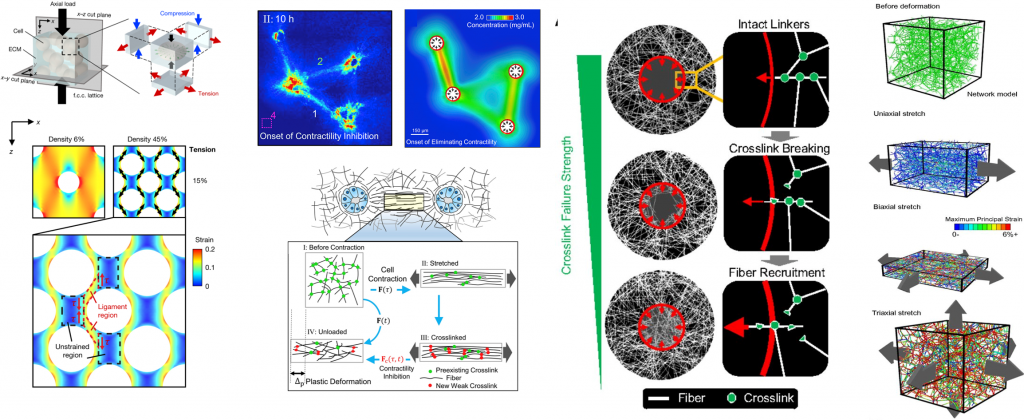Fibrous Materials

The role of mechanics in determining cell phenotype has been intensely studied since pioneering studies showed that cells in culture respond to differences in the elastic modulus of their environment. Stiffness sensing has been demonstrated in such varied settings as development, cancer, wound healing and fibrosis. However, how cells sense stiffness remains unclear, in part because of a lack of quantitative data that define exactly what cells sense, especially in vivo. Our work aims to characterize non-linear (strain-dependent) elasticity, viscoelasticity, and mechanical plasticity in normal and diseased tissues, in particular their contribution to cell stiffness sensing and behavior. We develop both discrete fiber network and continuum simulations to uncover how the ECM can mediate long range cell-cell communication, impact cellular contractility, and reorganize in response to cell activity.
Relevant contributions and publications
A. van Oosten*, X. Chen*, L. Chin, K. Cruz, A. E. Patteson, K. Pogoda, V. B. Shenoy, P. A. Janmey *Equal contributions
The Emergence of Tissue Mechanics from Confinement of Non-linear Biopolymer Networks by Densely Packed Cells
NATURE, 573: 96-101, 2019
E. Ban, H. Wang, J. M. Franklin, J. T. Liphardt, P. A. Janmey, and V. B. Shenoy
Strong Triaxial Coupling and Anomalous Poisson Effect in Collagen Networks
PROCEEDINGS OF THE NATIONAL ACADEMY OF SCIENCES, 116(14): 6790-6799, 2019
X. Cao, E. Ban, B. M. Baker, Y. Lin, J. A. Burdick, C. S. Chen, and V. B. Shenoy
A Multi-scale Model Predicts Increasing Focal Adhesion Size with Decreasing Stiffness in Fibrous Matrices
PROCEEDINGS OF THE NATIONAL ACADEMY OF SCIENCES, 114(23): E4549–E4555, 2017
H. Wang, A. Nair, C. S. Chen, R. Wells, and V. B. Shenoy
Long Range Force Transmission in Fibrous Matrices Enabled by Tension-Driven Alignment of Fibers
BIOPHYSICAL JOURNAL, 107(11):2592-2603, 2014